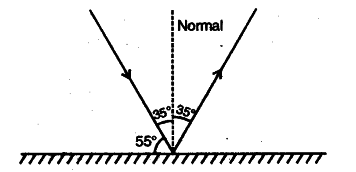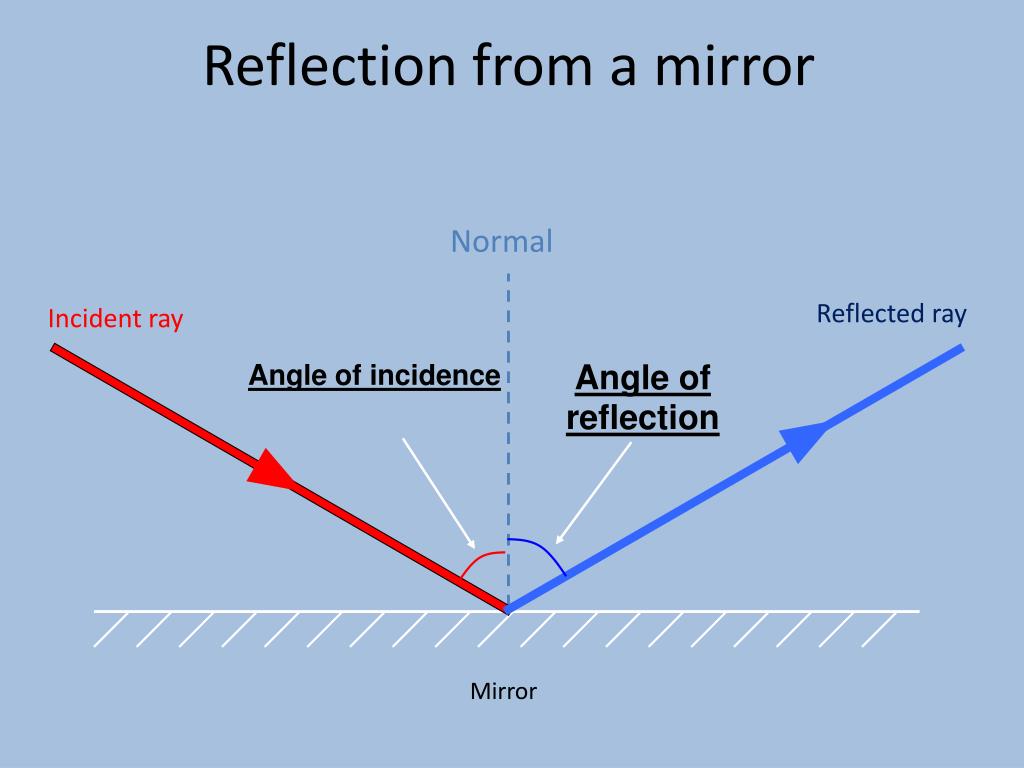



This reflected ray is extended behind the mirror Since the ray strikes the mirror perpendicular to its surface, the angle of incidence is zero (from the normal). The measured angles were identical or nearly identical in all trials, which seem to confirm the Law of Reflection. The angle of incidence and angle of reflection were measured for each trial. The ray table was rotated from 0 o to 90 o at 10 o intervals. A ray that strikes perpendicular to the mirror surface, reflects perpendicular to the mirror. A ray table was used to measure the angle at which the line hit and reflected off the mirror.Steps for drawing a plane mirror ray diagram: Virtual images formed by diverging light rays cannot be projected on a screen orientation=erect.Real images formed by converging light rays can be projected on a screen orientation=inverted.Convex mirrors A diverging mirror light rays that strike the mirror surface are reflected so that they diverge, or "go apart," and they never come to a point.Concave mirrors A converging mirror light rays that strike the mirror surface are reflected so that they converge, or "come together," at a point.Plane mirrors A flat mirror that reflects light rays in the same order as they approach the mirror.For light rays striking a plane mirror, the angle of reflection equals the angle of. Light rays diverging from a point at an angle theta fall on a mirror at two Figure 8 A flat mirror neither converges nor diverges light rays. There is a transversal as well as a longitudinal Doppler effect for light (and any combination for other than the two extreme angles). The normals drawn to the surface (at the point at which the incident ray strikes the surface) are nearly parallel. A plane mirror is a mirror with a flat (planar) reflective surface. begingroup The law of reflection breaks down because the frequency that is being reflected by the mirror is not the same as the original frequency, but its shifted by the Doppler effect. The light is coming in from material 1 (blue in the picture) on the left. The equations are solved for the incident, reflected, and transmitted angles and the materials' indices of refraction at the interface between two materials. Regular reflection When rays are reflected from a smooth surface, they are reflected so that a clear image is formed. The Angles of Reflection and Refraction Calculator provides calculations for reflection and refraction. None of the normals drawn to the surface (at the point at which the incident light ray strikes the surface) are parallel. The incident ray, the reflected ray, and the normal all lie in the same plane.ĭiffuse reflection When rays are reflected from a rough surface, they are reflected in many directions and no clear image is formed. Both of these angles are measured relative to a normal drawn to the surface. Law of Reflection When a light ray is incident upon a reflecting surface, the angle of reflection is equal to the angle of incidence. It's more like throwing a handful of marbles against a statue and then guessing the statue's shape based on how the marbles bounce.Reflection The bouncing back of a light ray from a surface. The law of reflection still applies, but instead of hitting one smooth surface, light is hitting many microscopic surfaces. This scattering is known as diffuse reflection and this is how our eyes interpret what happens when light hits an uneven surface. For instance, a beam of light traveling through space can't be seen from the side until it runs into something that scatters it, like a cloud of hydrogen or a satellite. Light itself is invisible until it bounces off something and hits our eyes. This is why the sun's glare during the evening and morning is so much more intense than during the rest of the day.
ANGLE OF REFLECTION OFF A MIRROR FULL
When light hits a surface at a low angle - like on a lake at sunset - it bounces off at the same low angle and hits your eyes full blast, rather than obliquely as when the sun sits overhead. The incoming angle, called the angle of incidence, is always equal to the angle leaving the surface, or the angle of reflection. The law of reflection says that when a ray of light hits a surface, it bounces in a certain way, like a tennis ball thrown against a wall. In order to understand mirrors, we first must understand light.


 0 kommentar(er)
0 kommentar(er)
